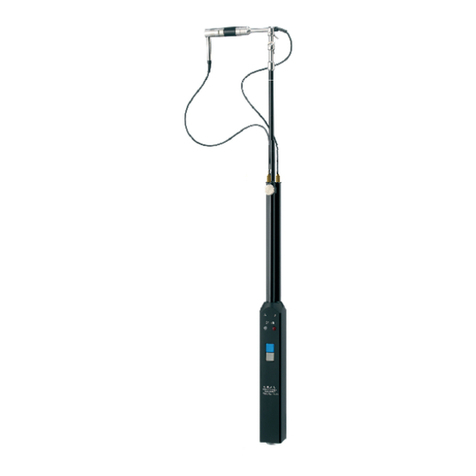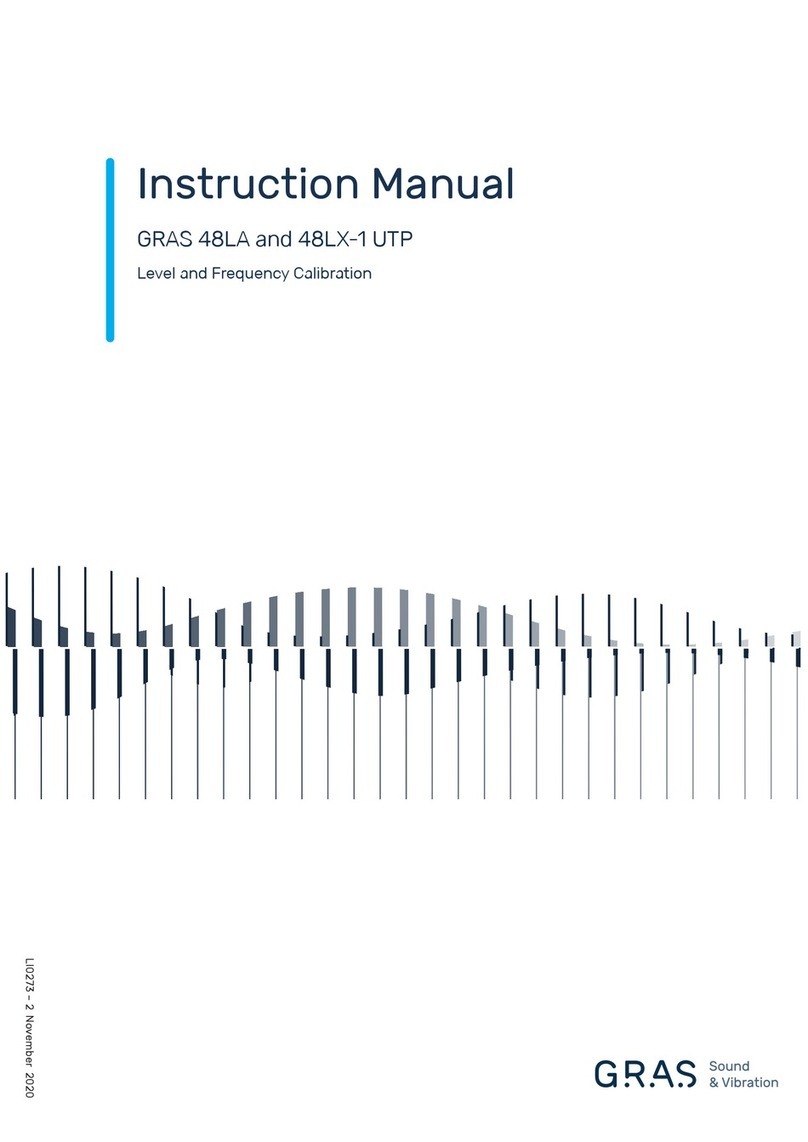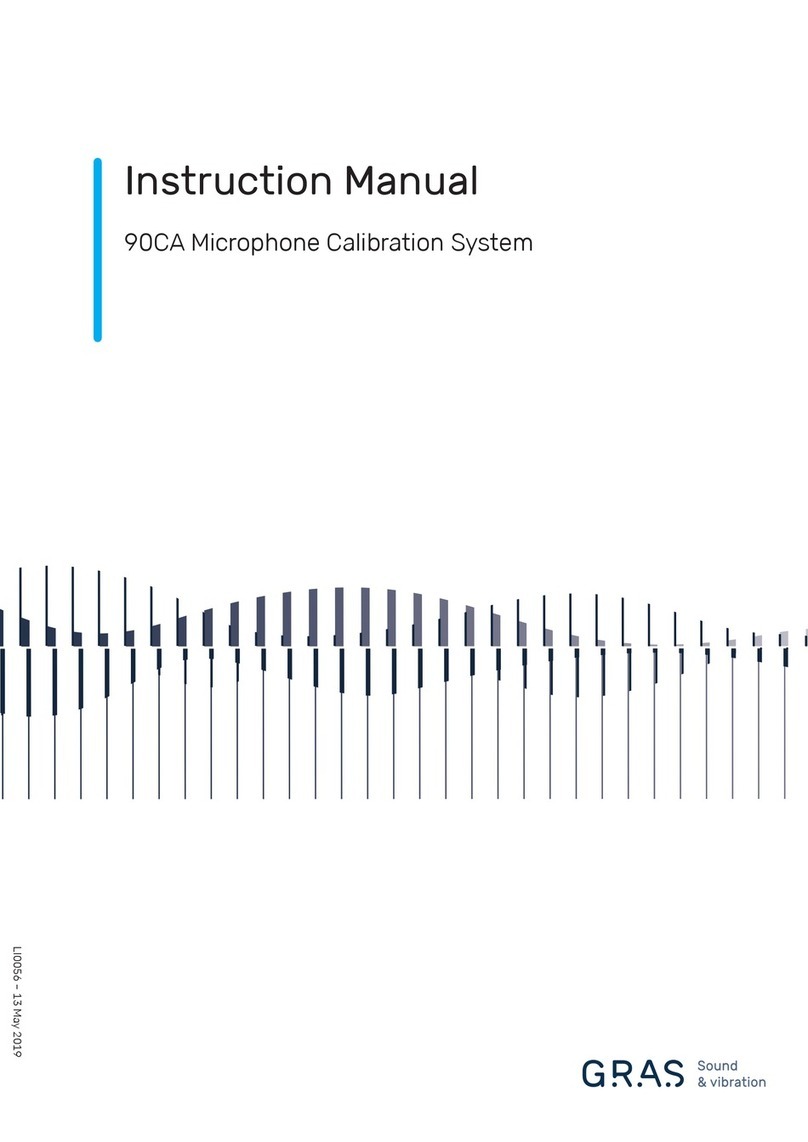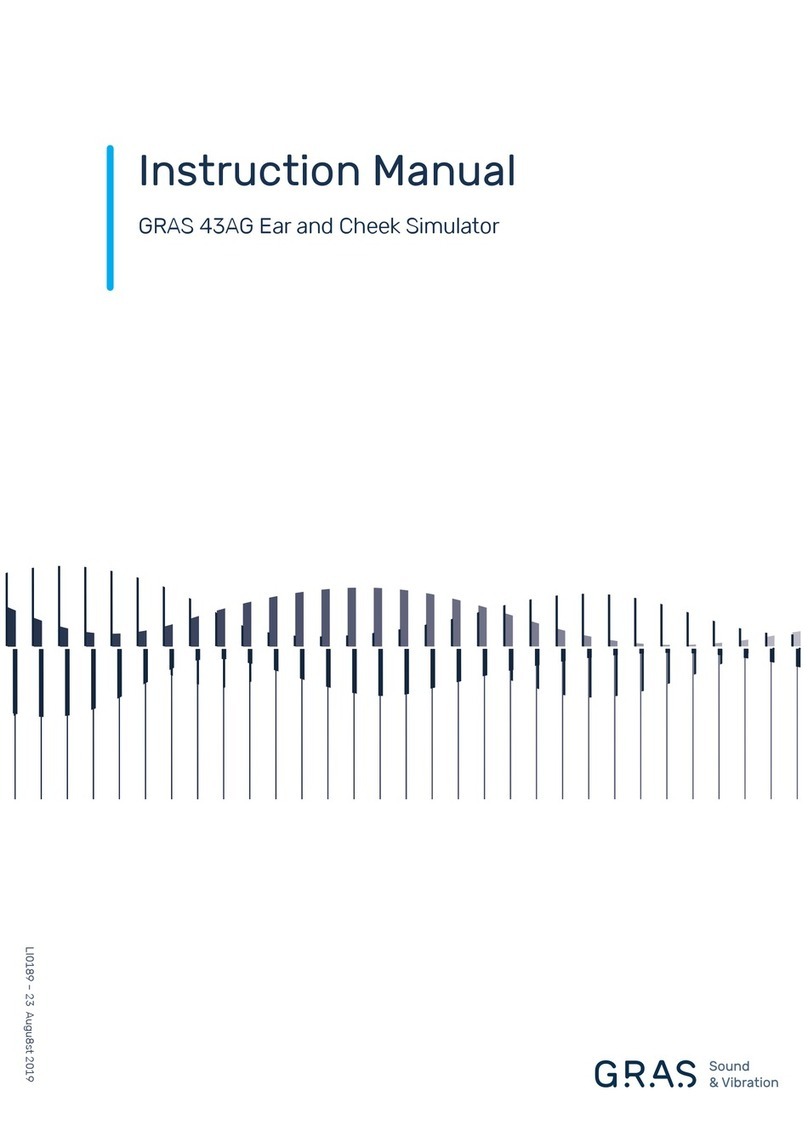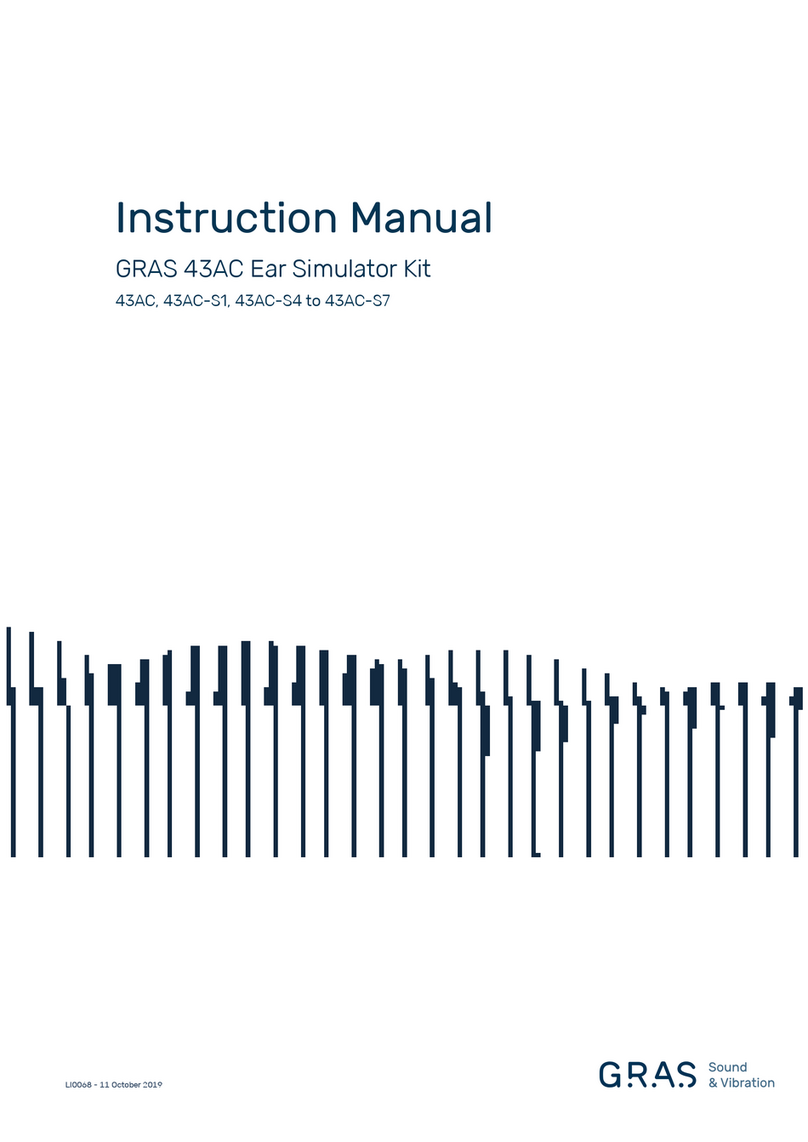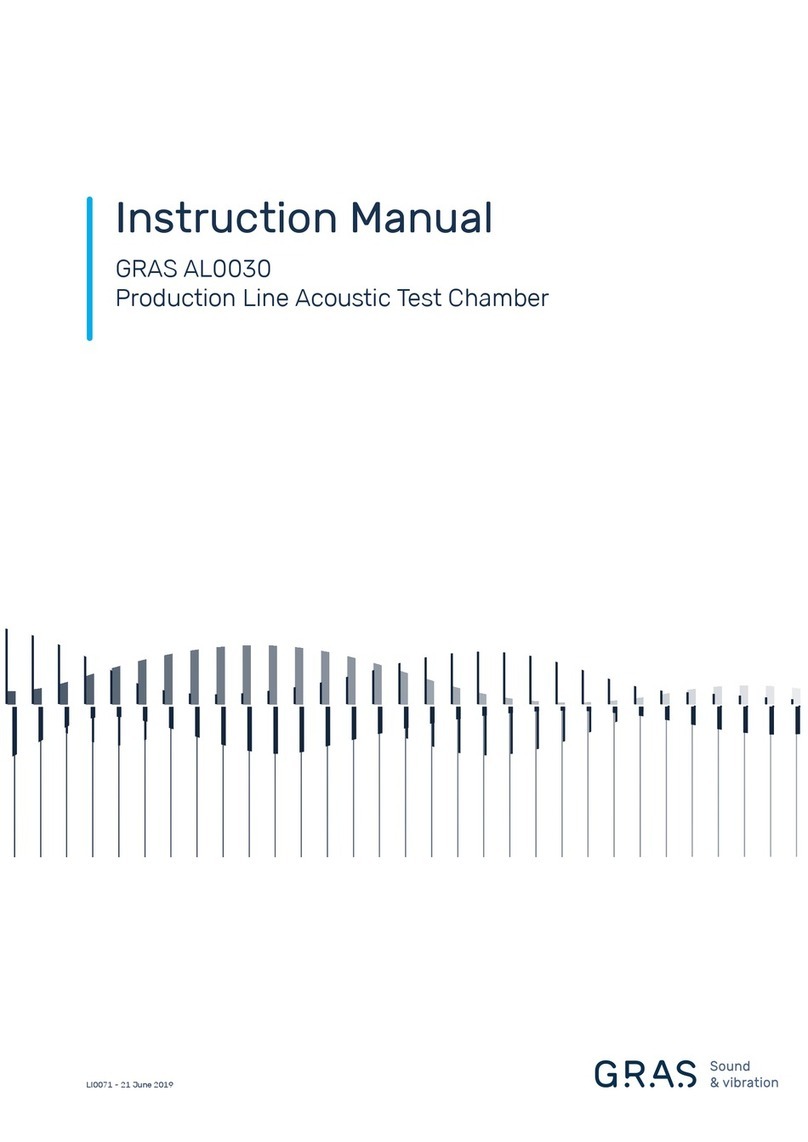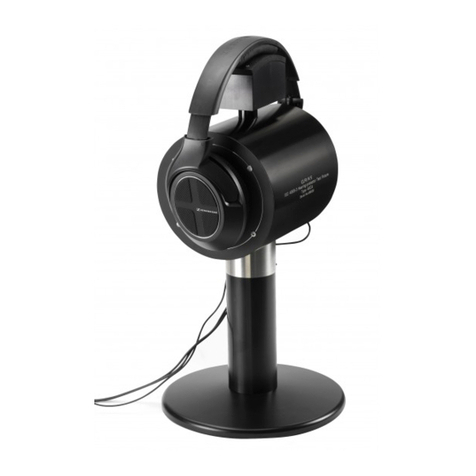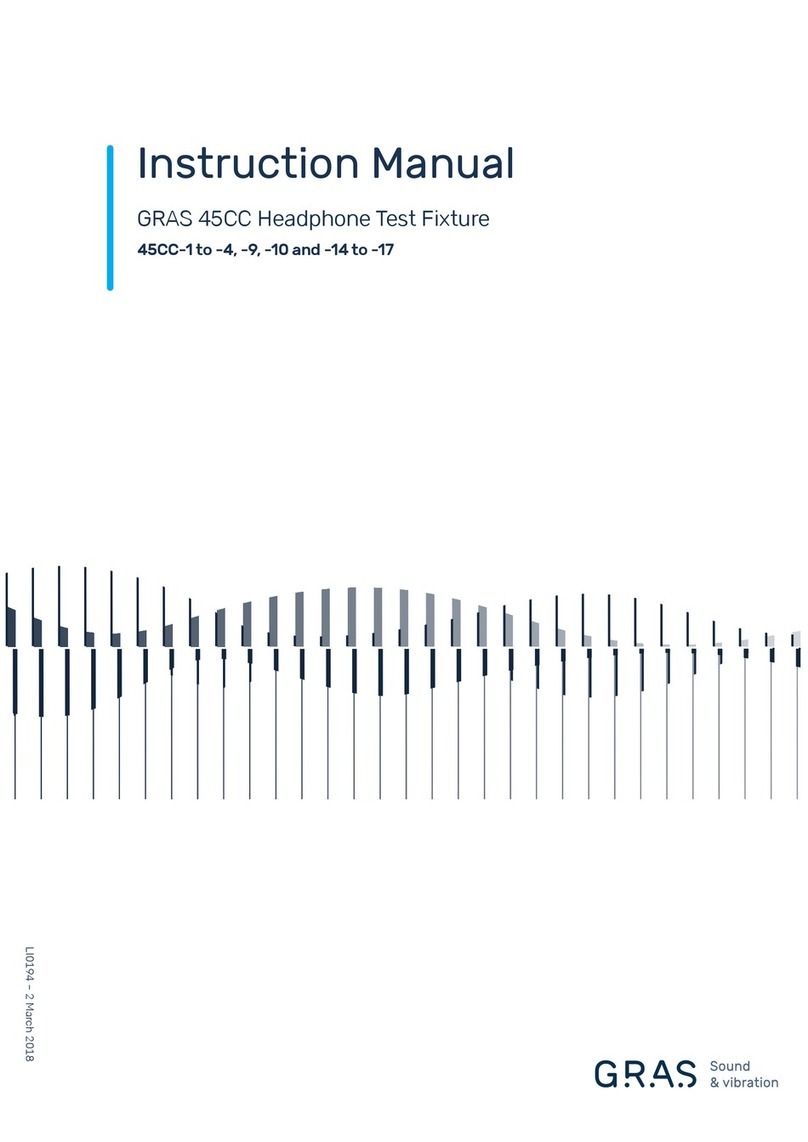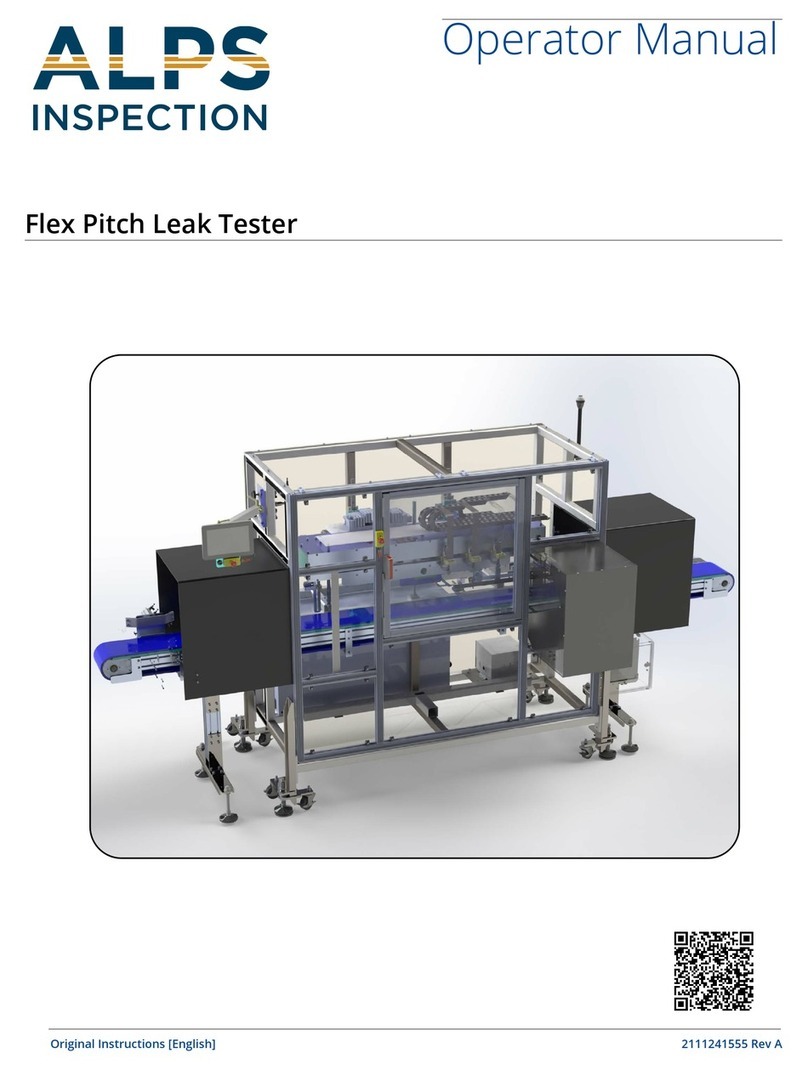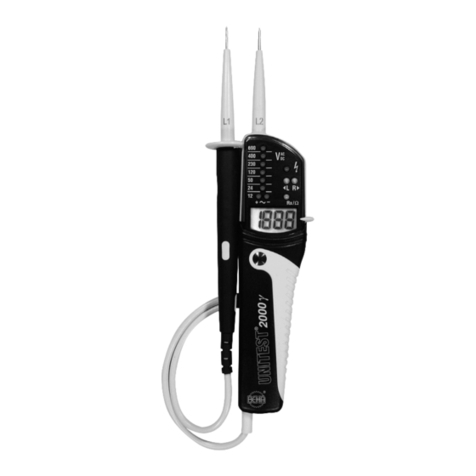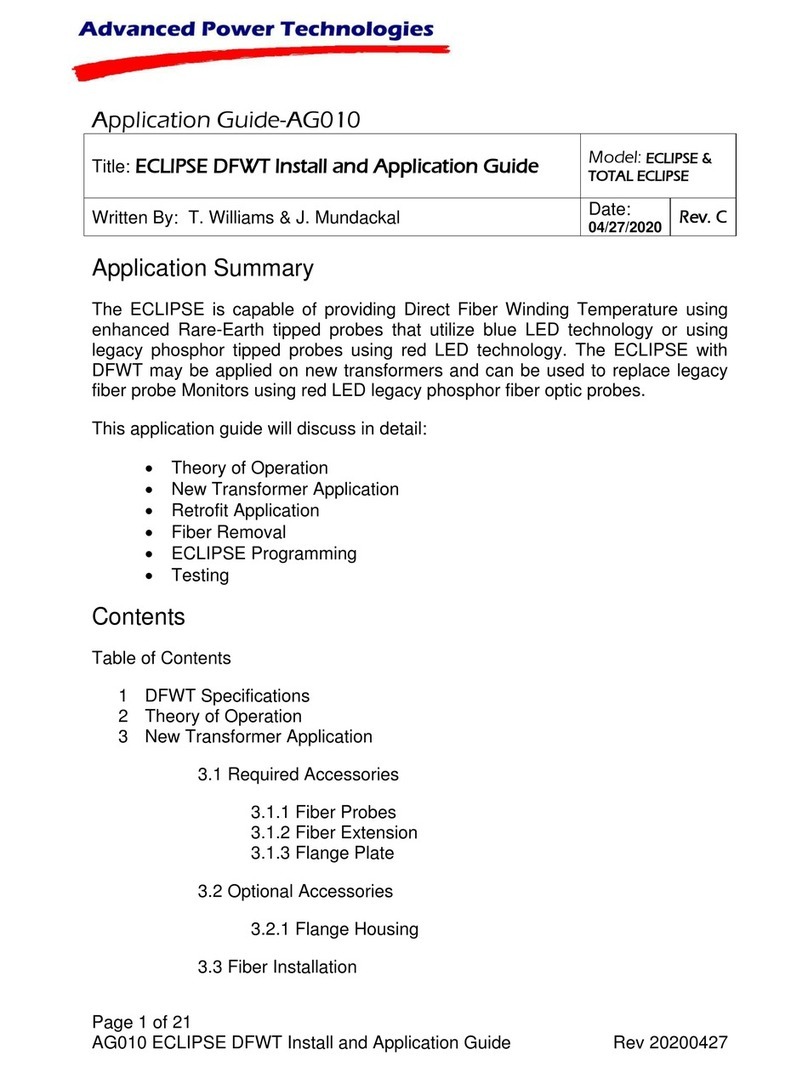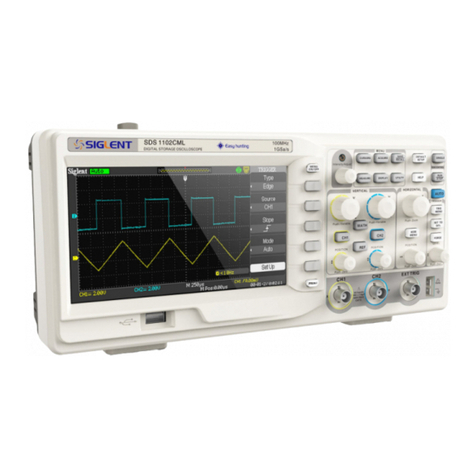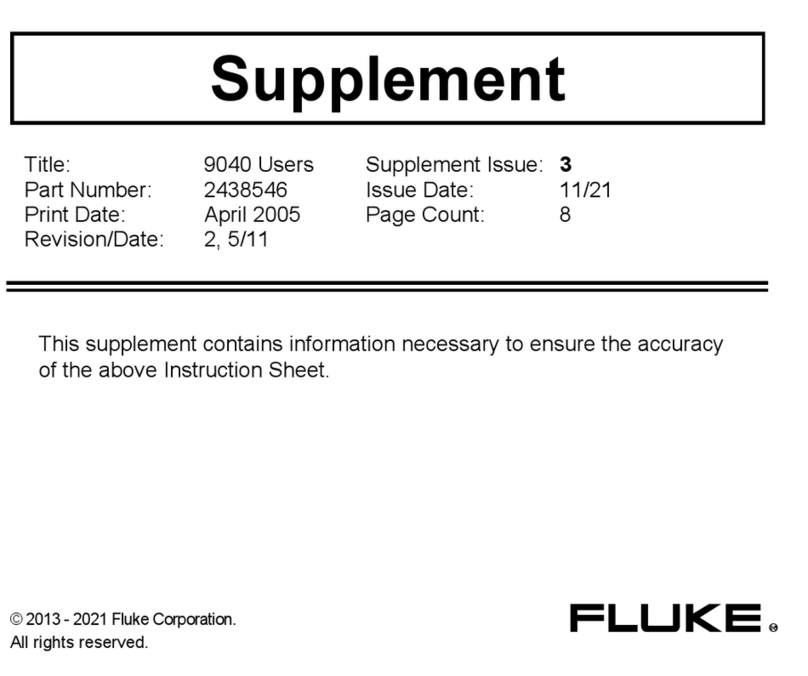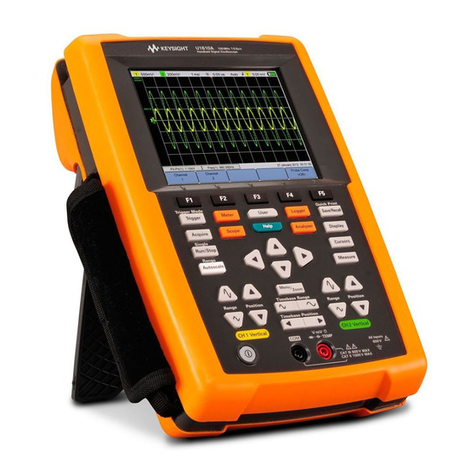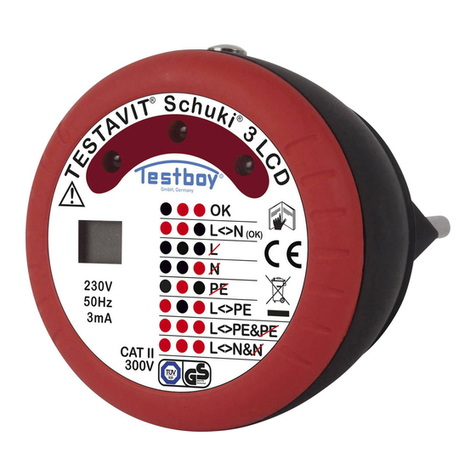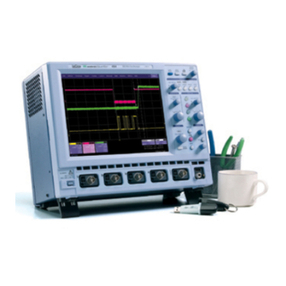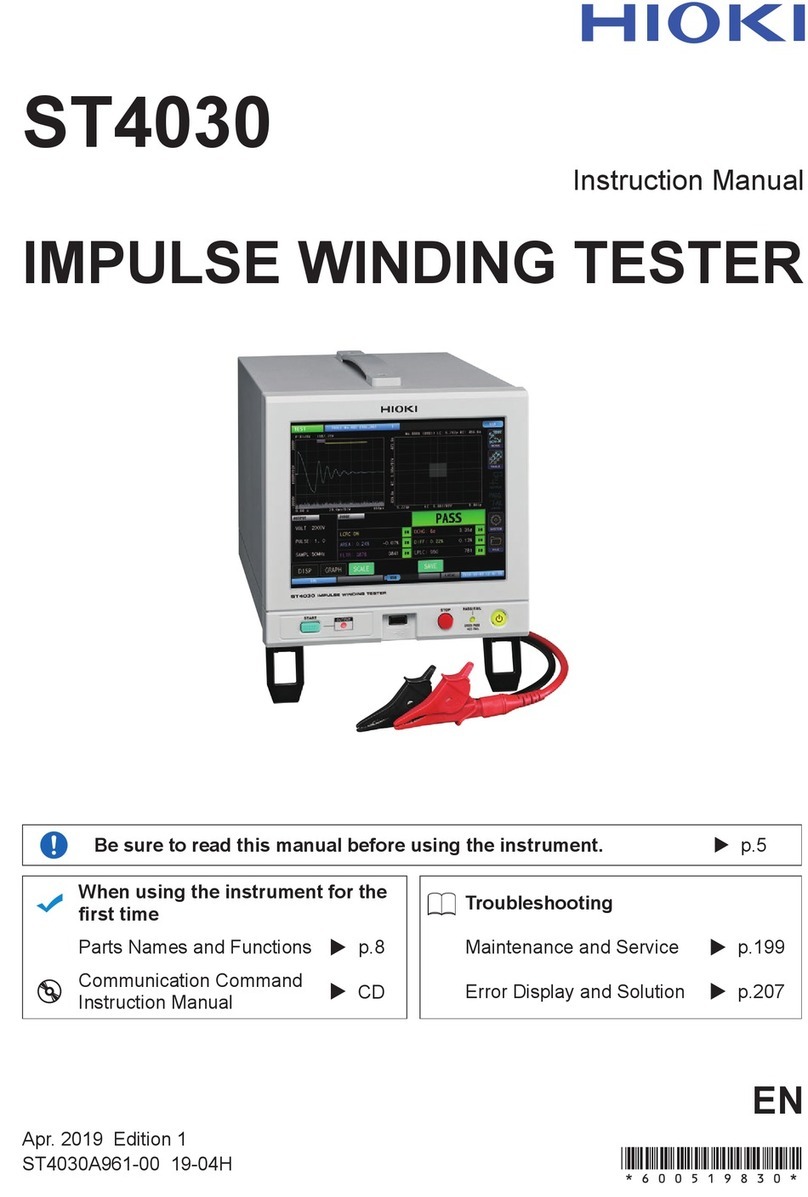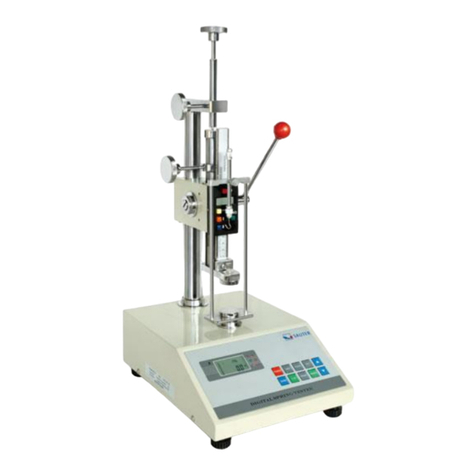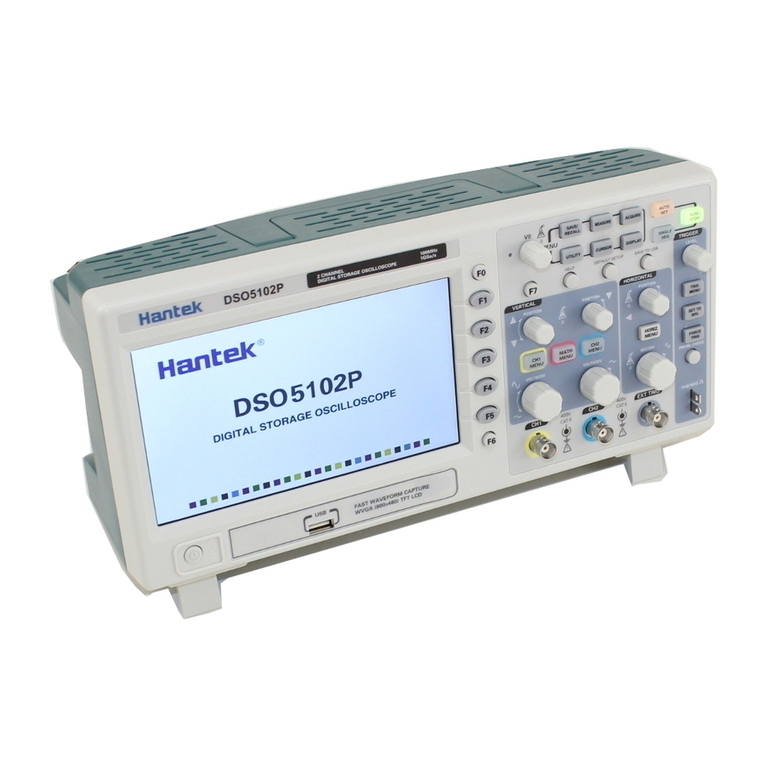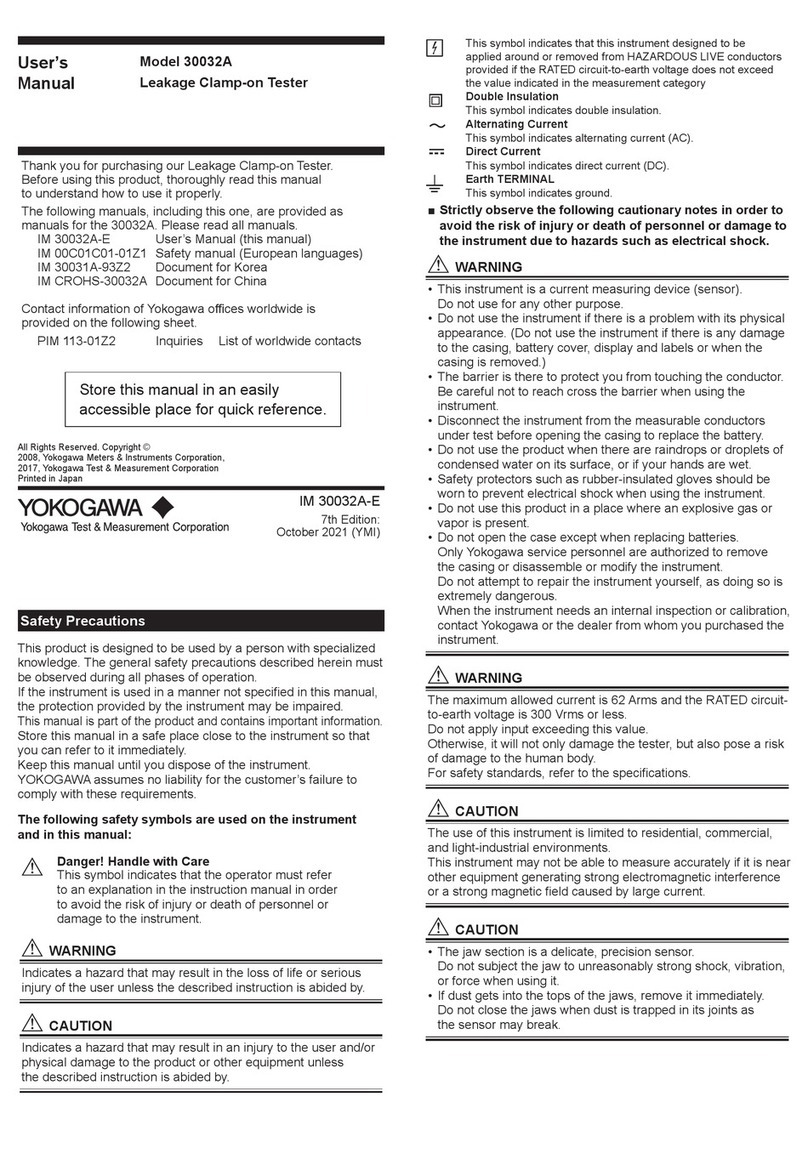GRAS 42AP User manual

Instruction Manual
Pistonphone Type 42AP
Skovlytoften 33, 2840 Holte, Denmark
SOUND & VIBRATION
G R A S
...
.
LI0053

G.R.A.S. Sound & Vibration
Revision History
Revision Date Description
1 1 October 2005 First publication
2 4 July 2013 Section 3.1 “Shipment and transport” added
Copyright Notice
© 2013 G.R.A.S. Sound & Vibration A/S
http://www.gras.dk
Any technical documentation that is made available by G.R.A.S. is the copyrighted work of G.R.A.S.
and is owned by G.R.A.S.
The content in this document is subject to change without notice. G.R.A.S. Sound & Vibration A/S is
not liable or responsible for any errors or inaccuracies that may appear in this document.
Trademarks
Product names mentioned in this document may be trademarks or registered trademarks of their
respective companies and are hereby acknowledged.
Before shipment, remove the batteries and wrap separately. Assure cautious han-
dling during transport. Remove the battery as soon as it is discharged or if the 42AP
is stored for a prolonged period of time. Leakage from the batteries may otherwise
destroy the electronic components.

G.R.A.S. Sound & Vibration
CONTENTS
1. General Description ..............................................5
1.1 Operation ........................................................5
1.1.1 Coupler Size. . . . . . . . . . . . . . . . . . . . . . . . . . . . . . . . . . . . . . . . . . . . . . . . . . . . . . . . . 5
1.2 Operating Frequencies ..............................................6
1.3 Calibration Level . . . . . . . . . . . . . . . . . . . . . . . . . . . . . . . . . . . . . . . . . . . . . . . . . . . 6
2. Theory .........................................................7
2.1 Principle .........................................................7
2.2 Volume Corrections. . . . . . . . . . . . . . . . . . . . . . . . . . . . . . . . . . . . . . . . . . . . . . . . . 7
2.3 Static-pressure Corrections ..........................................8
2.3.1 Built-in Barometer ....................................................9
2.3.2 Thermometer ........................................................9
3. Handling and Operation . . . . . . . . . . . . . . . . . . . . . . . . . . . . . . . . . . . . . . . . . . 10
3.1 Shipment and Transport ............................................10
3.2 Batteries ........................................................10
3.3 External Connector . . . . . . . . . . . . . . . . . . . . . . . . . . . . . . . . . . . . . . . . . . . . . . . . 10
3.3.1 External Power Supply. . . . . . . . . . . . . . . . . . . . . . . . . . . . . . . . . . . . . . . . . . . . . . . . 10
3.3.2 RS-232 Connection ..................................................10
3.4 Calibrating Microphones . . . . . . . . . . . . . . . . . . . . . . . . . . . . . . . . . . . . . . . . . . . . 11
3.4.1 Microphone Size ....................................................11
3.4.2 ½"Microphones .....................................................11
3.4.3 ¼"Microphones .....................................................12
3.4.4 ⅛"Microphones .....................................................12
3.4.5 1"Microphones .....................................................13
3.5 Calculation of Microphone Sensitivity . . . . . . . . . . . . . . . . . . . . . . . . . . . . . . . . . . 14
4. Remote Control via RS-232 Interface ...............................15
4.1 Introduction . . . . . . . . . . . . . . . . . . . . . . . . . . . . . . . . . . . . . . . . . . . . . . . . . . . . . . 15
4.2 Interface ........................................................15
4.3 Behaviour .......................................................17
4.4 Commands and Responses .........................................17
4.4.1 Interrogational Commands ............................................17
4.4.2 Setup Commands ...................................................18
4.4.3 Special Responses ..................................................18
5. Specications ..................................................19
A Appendix ......................................................21
A.1 Corrections for Static Ambient Pressure . . . . . . . . . . . . . . . . . . . . . . . . . . . . . . . . 21
A.2 Corrections for Humidity . . . . . . . . . . . . . . . . . . . . . . . . . . . . . . . . . . . . . . . . . . . . 21

G.R.A.S. Sound & Vibration

Button beside the LED
G.R.A.S. Sound & Vibration
Pistonphone Type 42AP - Page 5
1. General Description
The G.R.A.S. Pistonphone Type 42AP (Fig. 1.1) is a battery-operated, precision sound source
for accurate and reliable calibration of measurement microphones, sound level meters and other
sound measuring equipment.
1.1 Operation
When power is turned on, the coupler size will be displayed and the LED will light red.
After 1-2 sec. the frequency will be displayed, the Pistonphone will start and the LED will turn
green indicating that the Pistonphone is now locked to the operating frequency.
After another second or two the Pistonphone will be in normal operation mode, pressing the
button beside the LED will step the display to show the following (see Fig. 1.1):
• actual corrected sound pressure level in decibels re. 20 µPa
• actual corrected sound pressure level if measured with A-weighting in decibels re. 20 µPa
• static air pressure in h Pa
• calibration temperature in °C
• calibration temperature in °F
All information, including calibration data, can be read remotely via the RS-232 interface.
Fig. 1.1 Pistonphone Type 42AP shown with display examples
1.1.1 Coupler Size
It is important that the size of the coupler agrees with what is registered in the Pistonphone’s
memory. The Pistonphone can be tted with either a ½"coupler (RA0048) or a 1"coupler
(RA0023). Note: the coupler is calibrated together with the Pistonphone.
If the coupler size shown on the display (0.5 in or 1in) when rst switched on does not agree

G.R.A.S. Sound & Vibration
Pistonphone Type 42AP - Page 6
with the size of the coupler currently tted, do one of the following:
• Change the coupler to agree with what is displayed when the Pistonphone is rst switched
on.
OR
• Switch the Pistonphone off then while holding down the button beside the LED switch the
Pistonphone on again. The alternative coupler size will now be displayed.
1.2 Operating Frequencies
The operating frequency of the Pistonphone is programmable (see chapters 4 and 5) and is
selected via the RS-232 interface to be either 250 Hz
1or 251.2 Hz
2.
The current operating frequency is memorised and will be displayed for a short time on the
screen whenever the Pistonphone is switched on.
1.3 Calibration Level
With a microphone inserted in the Pistonhone’s coupler and the Pistonphone switched on, the
nominal calibration level is:
• 114 dB 3re. 20 µPa
The actual sound pressure level is shown on the display of Pistonphone, corrected for the static
ambient pressure. The display can be selected to correct for using an A-weighting lter.
An individual calibration chart is delivered with each Pistonphone.
The Pistonphone complies with all the requirements of IEC Standard 60942 (2003) LS and is an
extremely stable laboratory-standard sound source which can also be used for eld calibrations
- it retains its high accuracy even under hostile environmental conditions.
The Pistonphone works on the principle of two reciprocating pistons actuated by a precision-
machined cam disc with a sinusoidal prole. The rotation speed of the cam disc is controlled to
within 0.1% via a tachometer signal in a feed-back loop.
The operating procedure is straight forward, simply t the microphone into the coupler of the
Pistonphone and switch on. The Pistonphone will now produce a constant sound pressure level
on the diaphragm of the microphone.
The Pistonphone is delivered tted with the coupler (RA0048) for calibrating ½"microphones.
Adapters for calibrating ¼" and ⅛"microphones are included. A coupler (RA0023) for calibrating
1"microphones is also included.
Note: When the Pistonphone is calibrated, it must be calibrated with its ½”coupler (RA0048), its
1"coupler (RA0023), and, if purchased, the two-port calibration coupler (RA0024).
1Factory setting
2 True centre frequency of a 250 Hz ⅓-octave band lter
3114 dB is the equivalent of 10Pa

P = γ⋅P 0⋅2 A p⋅S
V ⋅√ 2(1)
G.R.A.S. Sound & Vibration
Pistonphone Type 42AP - Page 7
2. Theory
2.1 Principle
The Pistonphone works on the principle of a pair of similar opposing, reciprocating pistons
(Fig. 2.1) actuated by a precision-machined cam disc with a sinusoidal (SHM) prole. The cam
disc is mounted on the shaft of a small electric motor. The prole of the cam disc is such that the
pistons follow a sinusoidal movement at a frequency equal to four times the speed of rotation.
This results in a corresponding sinusodial variation in the effective volume of the closed coupler
and, consequently, an acoustic signal within it. The RMS pressure, P(in pascals), of this acous-
tic signal is given by:
Where :
γ is the ratio of specic heats for the gas in the coupler (for air this is 1.402 at 20 °C and
1 atm.)
P
0is the ambient pressure in pascals (Pa)
A
pis the cross-sectional area of one piston in square metres (m
2)
Sis the stroke length of the pistons in metres (m)
Vis the coupler volume in cubic metres (m
3)
A
pand Sare determined by the physical dimensions of the pistons and the cam disc; the ambi-
ent pressure refers, in most cases, to the barometric pressure of the atmosphere.
2.2 Volume Corrections
The volume of the coupler is dened partly by the dimensions of the coupler itself and partly the
effective load volume of the microphone. The effective load volume of the microphone is sum of
the equivalent volume and the front cavity volume. The front cavity volume of the microphone
is the volume between the microphone’s diaphragm and the protection grid plus the volume
contained in the slits of the protection grid.
The equivalent volume of the microphone is the apparent volume of the microphone behind the
diaphragm. Since the diaphragm is not perfectly stiff, it will be deected slightly by a sound pres-
sure. This slight deection of the diaphragm can be considered as equivalent to a small volume
and, as such, should be added to the sum of the grid and coupler volumes. Since the grid and
equivalent volumes can vary slightly from one type of microphone to another, the total volume of
the coupler will, accordingly, also vary slightly.
Fig. 2.1 Principle of the Pistonphone

∆ P = 20 ⋅Log ⋅( )
V
V + ∆ V
(2)
G.R.A.S. Sound & Vibration
Pistonphone Type 42AP - Page 8
A change in the total volume of the coupler will cause a change in the sound pressure level
generated within the coupler. A change in the sound pressure level ∆ P, in decibels, for a change
in coupler volume ∆ Vis given by:
Where:
V= 15540mm
3, including the effective load volume of 40AG
∆ Vis the equivalent volume correction
The Pistonphone is calibrated using a G.R.A.S. ½"Microphone Type 40AG. Since all G.R.A.S.
½"microphones have the same grid volume, the only correction necessary when calibrating the
various types is the correction for the various equivalent volumes
4.
Table 2.1 shows the equivalent volumes of G.R.A.S. ½"microphones and the corresponding
Pistonphone corrections.
4The G.R.A.S. Microphone Type 40AG is equivalent to the Brüel &Kjær Type 4134 and the volume correction for these are
0 dB. As a matter of interest, the volume correction for a G.R.A.S. Type 40AU and a Brüel &Kjær Type 4180 is 0.077 dB.
The equivalent volume uncertainty is ±7mm
3.
The correction uncertainty is ±0.004 dB.
No equivalent volume correction is needed for calibration of ¼"microphones (G.R.A.S. type
40BD, 40BE, 40BF, 40BP) using the adaptor RA0049, nor 1"microphone (G.R.A.S. type 40EN)
using the adaptor RA0023.
When calibrating 1/8"microphones (G.R.A.S. type 40DD, 40DP) using the adaptor RA0069 the
equivalent volume correction is +19mm
3and requires a correction -0.011 dB.
2.3 Static-pressure Corrections
The Pistonphone is factory adjusted to give a nominal sound pressure level of 114 dB re.
20 µPa. This nominal value is valid for the following ambient reference conditions:
• Temperature 23º C
• Static pressure 1013 hPa
• Relative humidity 50 %
Table 2.1 Corrections for G.R.A.S. ½″ microphones re.
the G.R.A.S. Microphone Type 40AG
G.R.A.S. Equiv-volume Correction
Mic. Type correction (mm
3) (decibels)
40AC – 20 0.011
40AD 20 – 0.011
40AE 25 – 0.014
40AF 30 – 0.017
40AN 25 – 0.014
40AP 25 – 0.014
40AQ 15 – 0.008
40AR 25 – 0.014
40AU – 137 0.077

SPL = 20 ⋅Log ⋅( ) + SPL
ref
P
a
P
r
(4)
∆ P = 20 ⋅Log ⋅( )
P
a
P
r
(3)
G.R.A.S. Sound & Vibration
Pistonphone Type 42AP - Page 9
The displayed pressure level is corrected (by an amount ∆ P) for static pressure variations given
by the following equation:
Fig. 2.2 Corrections for static ambient pressure
2.3.1 Built-in Barometer
The Pistonphone has a built-in precision barometer which measures and displays the static
ambient pressure. This value can also be used by the user for correcting sound pressure levels
for static ambient pressure. The Pistonphone already displays the corrected sound pressure
level, with and without A-weighting. The corrected sound pressure level (SPL) is calculated as
follows:
Where:
P
a = the displayed static ambient pressure (hPa)
P
r= reference static pressure (1013 hPa)
SPL = the actual sound pressure level in the coupler (decibels re. 20µPa)
SPL
ref = the sound pressure level at reference condition (decibels re. 20 µPa)
Note: SPL
ref is both stored in the memory of the Pistonphone and given on the calibration chart.
2.3.2 Thermometer
The Pistonphone has a thermometer that measures the temperature of the Pistonphone. The
thermometer tracks the actual calibration temperature in the measuring chamber to within a
degree. The measured temperature can be displayed both as °C and °F.
Where:
P
a= measured static ambient pressure (hPa)
P
r= reference static pressure (1013 hPa)
The corrections for ambient static pressure are shown in Fig. 2.2 (see also Appendix A.1 for an
extended pressure range).

G.R.A.S. Sound & Vibration
Pistonphone Type 42AP - Page 10
3. Handling and Operation
3.1 Shipment and Transport
Before any major shipment where rough handling is to be expected, remove the batteries to pro-
tect connectors and other internal parts from accidental damage.
Before shipment, remove the batteries and wrap separately.
Assure cautious handling during transport.
3.2 Batteries
The Pistonphone runs on four 1.5 V batteries (type AA [LR6]). To install or replace the batter-
ies, remove rst the lid of the battery compartment which is held in place by the screw shown in
Fig. 3.1. Slide the lid in the direction shown after removing the screw. Insert four new batteries
observing the correct polarity as indicated on the gure inside the battery compartment.
The Pistonphone can operate continuously for about 10 hours on a new set of batteries.
Remove the battery as soon as it is discharged or if the 42AP is stored for a
prolonged period of time. Leakage from the batteries may otherwise destroy
the electronic components.
Fig. 3.1 Access to batteries
3.3 External Connector
The Pistonphone has a 4-pin LEMO socket for both an external power supply and an RS-232 con-
nection (Fig. 3.1). Use the cable (AA0050) supplied for this purpose. The other end of this cable has
a 9-pin D-sub connector (for RS-232) with a 2mm DC socket for connecting to an external 6V DC
power supply (e.g. G.R.A.S. mains/line power supply AB0005). See also Fig. 4.1
3.3.1 External Power Supply
When an external 6 V DC (e.g. from a G.R.A.S. mains/line power supply AB0005) is applied to
the Pistonphone via the input socket, the Pistonphone is automatically switched on independ-
ent of the on/off (I/0) button (unless programmed otherwise, see section 4.4.2) and the internal
batteries are disabled.
3.3.2 RS-232 Connection
The RS-232 meets the electrical specications dened by EIA/TIA-232, the 9-pin D-sub connec-
tor is dened by EIA-574 Specications. Where:
Pin 2 for receive data (RX)
Pin 3 for transmit data (TX)
Pin 5 is ground which is connected to screen.
No other pins are connected.

L
C= L
N+ L
B+ L
V(5)
G.R.A.S. Sound & Vibration
Pistonphone Type 42AP - Page 11
3.4 Calibrating Microphones
3.4.1 Microphone Size
The Pistonphone is delivered ready to calibrate ½"microphones. For ¼" and ⅛"microphones,
special adapters are included. For 1"microphones, the 1"coupler
1 RA0023 has to be tted (see
Fig. 3.6). Each case is described in the following four sections.
3.4.2 ½"Microphones
Note: make sure the Pistonphone is set for the ½"coupler, see section 1.1.1.
To calibrate a ½" measurement microphone, rst loosen the microphone retention collar as
shown in Fig. 3.2. Then insert the microphone into the ½"coupler
1as shown in Fig. 3.3. Make
sure that the microphone is all the way in, then tighten the microphone retention ring so that the
microphone is held rmly in place.
Switch the Pistonphone on via the on/off (I/0) button. The LED above the on/off button is a
dual-colour LED for showing red or green. The LED shows green if the Pistonphone is operating
properly at the specied frequency. If the LED shows red or ashing red, the Pistonphone is not
operating at the specied frequency and the batteries should be changed (see section 3.2).
Wait approximately for 15 seconds for the static pressure in both the Pistonphone and the
microphone to stabilise, and for the microphone itself to stabilise within the coupler.
The static pressure within the coupler volume is equalised via an air-equalisation tube located
under the cap which protects the pistons and retention spring shown in Fig. 2.1.
With the Pistonphone switched on, the microphone is subjected to a sound pressure level L
C
given as the sum of the Pistonphone’s nominal sound pressure level L
N, the static pressure cor-
rection L
Band the volume correction L
V, i.e.:
Fig. 3.2 Loosening the microphone retention collar
Fig. 3.3 ½"microphone inserted in the coupler
1The ½"coupler is individual calibrated with the pistonphone, and these must be considered as a pair

L
C= L
N+ L
B+ L
V(6)
G.R.A.S. Sound & Vibration
Pistonphone Type 42AP - Page 12
3.4.3 ¼"Microphones
Note: make sure the Pistonphone is set for the ½"coupler, see section 1.1.1.
To calibrate a ¼" measurement microphone, rst loosen the microphone retention collar as
shown in Fig. 3.2. Then insert the ¼"microphone adapter (RA0049) into the ½"coupler as
shown on Fig. 3.4. Make sure that the adapter is all the way in, then tighten the microphone
retention collar so that the adapter is held rmly in place. Insert the ¼"microphone into the ¼"
adapter.
Switch the Pistonphone on via the on/off (I/0) button. The LED above the on/off button is a
dual-colour LED for showing red or green. The LED shows green if the Pistonphone is operating
properly at the specied frequency. If the LED shows red or ashing red, the Pistonphone is not
operating at the specied frequency and the batteries should be changed (see section 3.2).
Wait approximately for 15 seconds for the static pressure in both the Pistonphone and the
microphone to stabilise, and for the microphone itself to stabilise within the coupler.
The static pressure within the coupler volume is equalised via an air-equalisation tube located
under the cap which protects the pistons and retention spring shown in Fig. 2.1.
With the Pistonphone switched on, the microphone is subjected to a sound pressure level L
C
given as the sum of the Pistonphone’s nominal sound pressure level L
N, the static pressure cor-
rection L
Band the volume correction L
V, i.e.:
Fig. 3.4 ¼"microphone adapter inserted
in the coupler
3.4.4 ⅛"Microphones
Note: make sure the Pistonphone is set for the ½"coupler, see section 1.1.1.
To calibrate a ⅛" measurement microphone, rst loosen the microphone retention collar as
shown in Fig. 3.2. Then insert the ⅛"microphone adapter (RA0069) into the ½"coupler as
shown on Fig. 3.4. Make sure that the adapter is all the way in, then tighten the microphone
retention collar so that the adapter is held rmly in place. Insert the ⅛" microphone into the ⅛"
adapter.
Switch the Pistonphone on via the on/off (I/0) button. The LED above the on/off button is a
dual-colour LED for showing red or green. The LED shows green if the Pistonphone is operating
properly at the specied frequency. If the LED shows red or ashing red, the Pistonphone is not
operating at the specied frequency and the batteries should be changed (see section 3.2).
Wait approximately for 15 seconds for the static pressure in both the Pistonphone and the
microphone to stabilise, and for the microphone itself to stabilise within the coupler.
The static pressure within the coupler volume is equalised via an air-equalisation tube located
under the cap which protects the pistons and retention spring shown in Fig. 2.1.

L
C= L
N+ L
B+ L
V(7)
G.R.A.S. Sound & Vibration
Pistonphone Type 42AP - Page 13
Fig. 3.6 1"and ½"couplers
With the Pistonphone switched on, the microphone is subjected to a sound pressure level L
C
given as the sum of the Pistonphone’s nominal sound pressure level L
N, the static pressure cor-
rection L
Band the volume correction L
V, i.e.:
3.4.5 1"Microphones
Note: make sure the Pistonphone is set for the 1"coupler, see section 1.1.1.
To calibrate a 1"measurement microphone, the ½"coupler has to be replaced by the 1"cou-
pler
1(RA0023), see Fig. 3.6. Unscrew the ½"coupler from the Pistonphone body. The pistons
and retention spring shown in Fig. 2.1 are protected so there is no risk of accidentally damaging
these parts when removing the coupler. Screw the 1"coupler (RA0023) onto the Pistonphone
body. Then insert the 1"microphone into the 1"coupler. Make sure that the microphone is all the
way in.
Fig. 3.5 ⅛"microphone adapter inserted
in the coupler
1The 1"coupler is individual calibrated with the pistonphone, and these must be considered as a pair

S = (9)
V
o
20 μPa ⋅10L
c20
L
C= L
N+ L
B+ L
V(8)
G.R.A.S. Sound & Vibration
Pistonphone Type 42AP - Page 14
Switch the Pistonphone on via the on/off (I/0) button. The LED above the on/off button is a
dual-colour LED for showing red or green. The LED shows green if the Pistonphone is operating
properly at the specied frequency. If the LED shows red or ashing red, the Pistonphone is not
operating at the specied frequency and the batteries should be changed (see section 3.2).
Wait approximately for 15 seconds for the static pressure in both the Pistonphone and the
microphone to stabilise, and for the microphone itself to stabilise within the coupler.
The static pressure within the coupler volume is equalised via an air-equalisation tube located
under the cap which protects the pistons and retention spring shown in Fig. 2.1.
With the Pistonphone switched on, the microphone is subjected to a sound pressure level L
C
given as the sum of the Pistonphone’s nominal sound pressure level L
N, the static pressure cor-
rection L
Band the volume correction L
V, i.e.:
3.5 Calculation of Microphone Sensitivity
The sensitivity of a microphone under test can be calculated via a measurement of the micro-
phone’s output voltage. If the measured output voltage is V
o, and the sound pressure level in
the Pistonphone’s coupler is L
C(decibels), the microphone sensitivity Sis given by:
The value 20 μPa is the standard reference sound pressure. The result here includes the load-
ing effect of the preamplier’s input impedance as well as the gain or attenuation within the
preamplier. To measure the “Open Circuit Sensitivity” of the microphone (i.e. when the micro-
phone’s output is not affected by the load of a preamplier), a special preamplier, for example
the G.R.A.S. Type 26AG (which has insert voltage calibration capability), should be used.

To a COM port, e.g. COM2
Socket for
external
power supply
AA0050
G.R.A.S. Sound & Vibration
Pistonphone Type 42AP - Page 15
4. Remote Control via RS-232 Interface
4.1 Introduction
Commands and responses, comprising ASCII characters, can be sent to and from the Piston-
phone via its RS-232 interface, using a suitable utility program (e.g. HyperTerminal
1as illus-
trated in the following).
4.2 Interface
Connector: RS-232 9-pin D-sub using adapter cable AA0050
RS-232: 9600,8,n,1
(i.e. 9600 bits per second, 8 data bits, no parity bit, 1 stop bit)
There is no ow control/handshaking; therefore commands must be sent one by one, waiting for
each response.
The input buffer is 32 bytes, in case of overow, a response “Buffer overow” will be submitted.
This will not happen under normal conditions.
Fig. 4.1 shows how the Pistonphone should be connected to the computer and Figs. 4.2 and
4.3 show the relevant dialogue boxes (of HyperTerminal) for selecting the COM port in use and
entering the required settings, i.e. 9600,8,n,1 as mentioned above.
Note: The RS-232 connection must always be made with the Pistonphone disconnected from an
external power supply.
Fig. 4.1 Pistonphone connection to computer
1Developed for Microsoft
®by Hilgraeve Inc.

G.R.A.S. Sound & Vibration
Pistonphone Type 42AP - Page 16
Fig. 4.3 Showing the correct setup for the selected
COM port
Fig. 4.2 Selecting the COM port in use, e.g.
COM2

G.R.A.S. Sound & Vibration
Pistonphone Type 42AP - Page 17
4.3 Behaviour
When the Pistonphone is powered up, a “Ready”<CRLF> messages is sent.
A watchdog will restart the Pistonphone if the processor stops working.
4.4 Commands and Responses
About commands:
Two types of command are used. These are:
1. Interrogational commands
which return information about the Pistonphone, its setup parameters and measured
ambient conditions.
2. Setup commands
which are for changing setup parameters and controlling the Pistonphone.
Syntax
1. Commands are not case sensitive.
2. All commands are executed by rst typing in the command then striking the <Enter>
1
key (usually symbolised nowadays by “”), e.g.:
C...if you want to know the temperature in the Pistonphone’s coupler in °C.
For clarity, <Enter> and “” are implied if not shown in the following.
About responses:
1. All responses to commands are followed by <CRLF>
2.
For clarity, <CRLF> is implied in the following.
4.4.1 Interrogational Commands
Commands Responses
CReturns temperature measured inside the Pistonphone in °C.
FReturns temperature measured inside the Pistonphone in °F.
hPa Returns static pressure in hPa.
dB Returns actual corrected sound pressure level in dB
dBA Returns actual corrected sound pressure level in dB
measured with an A-weighting lter.
type Returns “G.R.A.S. Type 42AP”.
serial Returns, e.g. “Serial no.: 46345”.
rmware Returns “Firmware ver. 1.1”.
info Equivalent to commands type, serial and rmware.
frequency Returns currently selected Pistonphone frequency in Hz, e.g. “250”.
status Returns “locked” or “not locked”.
coupler Returns selected coupler size in inches, e.g. “0.5”.
SPLref.used Returns the currently selected reference level in decibels, e.g.
“114.01”.
SPLref.0.5in Returns calibration level in decibels at reference conditions for a
½″ coupler, e.g. “114.01”.
SPLref.1in Returns calibration level in decibels at reference conditions for a
1″ coupler.
1The equivalent of <CRLF> i.e. “Carriage Return Line Feed”. However, the commands ignore the <LF>.
2“Carriage Return Line Feed” which moves the cursor to the start of a new line.

Pistonphone pow-
ered up
Commands
Response to the command C
G.R.A.S. Sound & Vibration
Pistonphone Type 42AP - Page 18
4.4.2 Setup Commands
Command Response
ON Turns on the Sound pressure
OFF Turns off the Sound pressure
250HZ Set Pistonphone frequency to 250Hz and memorise setting
251.2HZ Set Pistonphone frequency to 251.2Hz and memorise setting
0.5in Set coupler size to ½″ and SPL
ref to that used for factory calibration.
Note: command valid only if the Pistonphone is calibrated for this
coupler size. It also cancels any current user-applied correction.
1in Set coupler size to 1″ and SPL
ref to that used for factory calibration.
Note: command valid only if the Pistonphone is calibrated for this
coupler size. It also cancels any current user-applied correction.
restart Restarts the Pistonphone, allow about 1 second for restart.
Empty command, returns OK.
All setup commands will return OK if successful or Error if not.
4.4.3 Special Responses
ready Submitted when the Pistonphone is powered up.
Fig. 4.4 shows an example of a dialogue between user and Pistonphone. Each command is
followed immediately by the response. In this example, the terminal has been setup to echo the
outgoing commands.
Fig. 4.4 Example of a dialogue showing commands and responses

G.R.A.S. Sound & Vibration
Pistonphone Type 42AP - Page 19
5. Specications
Sound pressure level:
Nominal: 114 dB re. 20 µPa
Individually calibrated under the following reference conditions:
Ambient pressure: 1013 hPa
Ambient temperature: 20 °C
Ambient humidity: 65% RH
Calibration accuracy:
Absolute: 1/2” mic.: ±0.09 dB at reference condition
1” mic.: ±0.2 dB at reference condition
When corrected for 1/2” mic.: ±0.1 dB
ambient pressure: 1” mic.: ±0.2 dB
Frequencies:
250 Hz ± 0.1%
251.2 Hz ± 0.1%
Distortion:
<1.5%
Barometer:
Range: 750 hPa to 1100 hPa
with reduced
accuracy (± 4hPa): 300 hPa to 1100h Pa
Calibration accuracy:
Absolute: ± 1 hPa (0 °C to +55 °C)
Long-term stability: – 1 hPa (12 months)
Thermometer:
Range: – 10 °C to + 55 °C
Absolute: ± 1 °C
Nominal effective coupler volume:
15540 mm 3(including effective load volume of microphone type 40AG or type 40EN)
Temperature range:
Batteries permitting: – 10 °C to + 55 °C
Batteries:
Four standard LR6-AA alkaline cells
External power:
Voltage: 6 V DC
Current: 90 mA
Dimensions:
Length: 184 mm (7.24 in)
Width: 35 mm (1.38 in)
Height: 35 mm (1.38 in)
Weight (with batteries): 437 g (1 lb)

G.R.A.S. Sound & Vibration
Pistonphone Type 42AP - Page 20
1 For Pistonphones tted with a 1″ microphone coupler RA0023
Fig. 5.1 Two-port Coupler RA0024 shown
here with the two phase-matched
microphones of an intensity probe
Accessories included:
Adapter for ¼"microphones: RA0049
Adapter for ⅛"microphones: RA0069
Coupler for 1"microphones: RA0023
Coupler for ½"microphones: RA0048
Four LR6-AA alkaline cells: EL0001
Adapter cable for RS-232
and external power supply AA0050
Accessories available:
Mains/line power supply AB0005
Adapter for Outdoor Microphone System
1:-
Type 41AM: RA0009
Type 41CN: RA0041
Adapter for Environmental Microphone
1:-
Type 41AL: RA0010
Two-port calibration coupler: RA0024 (see Fig. 5.1)
Octopus coupler (½"mics.): RA0072
Note: When the Pistonphone is calibrated, it must be calibrated with its ½”coupler (RA0048), its
1”coupler (RA0023), and, if purchased, the two-port calibration coupler (RA0024).
WEEE directive:
2002/96/EC
CE marking directive:
93/68/EEC
Manufactured to conform with:
RoHS directive:
2002/95/EC
Table of contents
Other GRAS Test Equipment manuals
